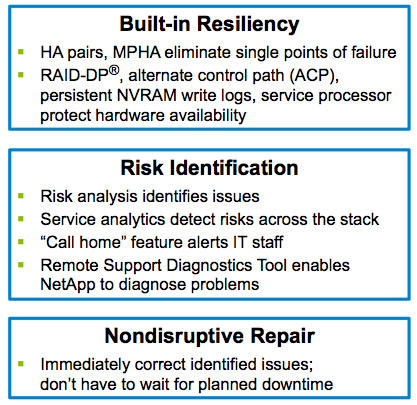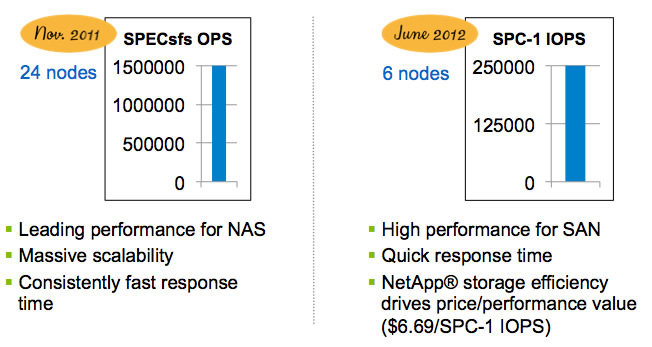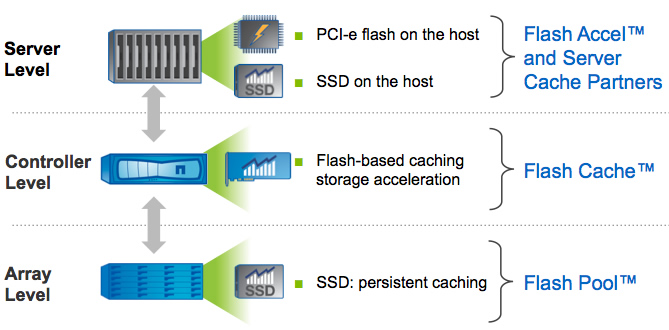


No matter what you call them—tier 1, business critical, mission critical—every organization has one or two applications that place extreme demands on storage to deliver availability and performance. As the leader of the NetApp team focused on this space, I hear from a lot of NetApp customers about how and why they deploy FAS6200 systems to address the needs of their most important applications. The enterprise-class availability that the FAS6200 provides is a consistent theme, and more and more, I’m hearing about how the FAS6200 helps customers quickly adjust, scale, and consolidate their IT infrastructure.
NetApp continues to add value to its flagship FAS6200 platform—as well as equivalent V-Series models for virtualizing third-party storage—with capabilities like Data ONTAP® clustering and our portfolio of Virtual Storage Tier (VST) technologies, including Flash Cache™, Flash Pool™, and FlashAccel™. We just released three new FAS6200 models—the FAS6220, FAS6250, and FAS6290—that have been further optimized to take advantage of these capabilities.
The combination of rock-solid availability coupled with the ability to “move at the speed of business” is what sets the FAS6200 and NetApp apart. It’s no longer enough just to have storage that runs 24/7/365; your storage has to support the evolving needs of your business, allowing you to optimize cost and maximize the availability of core IT services without sacrificing performance.
Avoiding Unplanned Downtime

To help you avoid unplanned downtime, the FAS6200 and V6200 combine proven, reliable hardware with risk-detection capabilities to identify and help you correct issues before they cause an outage. NetApp tracks availability across its installed base of storage systems using data from AutoSupport™. As a result, when we say that the measured availability of the FAS6200 is 99.999% (about 5 minutes of downtime per year) that number really means something.
Risk Detection and Service Analytics
The data collected by AutoSupport is also used to identify risks and protect the availability of your storage. NetApp uses big data analytics to identify patterns in billions of rows of log data that we gather from thousands of deployed storage systems. My AutoSupport lets you use the risk signatures that result from this ongoing data analysis to identify and proactively address issues that could affect your operations.

Figure 1) NetApp combines resilient hardware with risk identification and nondisruptive repair to eliminate unplanned downtime. Potential issues can be identified and corrected before they have a chance to affect availability.
Advanced service analytics using NetApp® OnCommand® Insight and OnCommand Balance tools extend risk detection beyond the boundaries of storage to include networks, servers, and virtual machines. End-to-end visibility of service paths allows you to verify that you are adhering to your defined processes and policies and can help identify vulnerabilities, even when they span across the stack. Troubleshooting features let you find and fix problems before they affect your operations and respond much more quickly if problems do arise.
These tools have been shown to improve storage availability and to reduce the number of priority 1 support cases by up to 80%, as well as to increase the speed with which cases are resolved.
Utility Company Relies on OnCommand Insight
A major utility company in the western United States learned firsthand the benefits of deploying these tools. The company runs its tier 1 ERP applications on NetApp FAS6200 storage. The IT team started out using NetApp storage for most of its tier 2 and tier 3 applications and quickly came to rely on NetApp because of our demonstrated reliability, ease of management, and excellent support.
The team uses OnCommand Insight to provide a detailed view of relationships between virtualized server infrastructure and storage. Insight allows them to identify and diagnose misbehaving virtual machines, saving hours of troubleshooting time. It quickly became clear that this tool saves them money during diagnosis of performance problems. The initial prognosis was that more storage was needed to support the workload. Using the Insight tool, the IT team determined that the problem was a host memory issue that had nothing to do with storage, thereby postponing the purchase of additional storage.
Avoiding Planned Downtime

In many environments, planned downtime has become more of a problem than unplanned downtime. It’s becoming almost impossible to identify windows when data can be taken offline for storage system maintenance. NetApp has taken steps to eliminate planned downtime with nondisruptive operations on both FAS/V6200 HA pairs and Data ONTAP clusters.
Most FAS/V6200 systems that currently support critical applications in the field are deployed in HA pairs. The two controllers in an HA pair are active-active, with both serving data and providing full redundancy in the event of any trouble. When maintenance or upgrade is required, one controller can take over the other’s workload temporarily so the flow of data is not interrupted. When the work is completed on one controller, the roles reverse if necessary so that no planned downtime is required.
Healthcare Provider Relies on FAS6200 Availability
As an example of why this matters, think about healthcare facilities where having data online can literally be a matter of life and death. One major U.S. healthcare provider chose the FAS6200 series specifically for its proven reliability, nondisruptive operations, and great performance characteristics.
FAS6200 storage is used for all the data for imaging systems such as CT and MRI scans. Medical professionals may need to access imaging information around the clock and at a moment’s notice to make critical decisions about treatments. Total storage is growing at 35% per year, and imaging systems account for two-thirds of the storage. With the availability and simplified management of the FAS6200, this provider has been able to offer rock-solid reliability and keep operational costs down, managing 4.5PB of SAN and NAS storage infrastructure plus all data protection services across 20+ hospitals with just 12 people.
Clustered Data ONTAP Eliminates Planned Downtime
The FAS6200 and V6200 availability picture gets even rosier when you deploy clustered Data ONTAP—cluster deployments are growing fast, with well over 1,000 clusters in place. Once multiple controllers are clustered together, active data can be moved from one controller to another without disruption. With these capabilities, virtually any activity can be accomplished using nondisruptive operations. You can easily rebalance workloads, and all maintenance activities and upgrades—even those that require power cycling or replacing disk shelves—can be accomplished without planned downtime.
Figure 2) Clustered Data ONTAP benefits.
A recent study suggests that the added expense associated with migrating data from an old array to a new one adds almost 50% to the cost of owning an array. Clustered Data ONTAP lets you accomplish full hardware refreshes quickly and easily without taking data offline, thereby avoiding these hidden costs. Because clustered storage systems aren’t required to be the same generation or model, you can replace one FAS platform with another—or change your entire storage infrastructure—without interrupting running applications or busy users. No other storage vendor can do this.
Delivering Consistent Performance

Having a bottleneck slow down your business-critical application can be almost as bad as having the application offline, because these applications require consistent high performance. The FAS6200 delivers proven performance for both SAN and NAS protocols, as measured using industry-standard SPECsfs and SPC-1 benchmarks.

Figure 3) Performance of FAS6200 clusters on SPECsfs and SPC-1 benchmarks.
Although benchmarks are important, results in the real world are what matter most. The healthcare provider I mentioned earlier recently moved a number of important SQL applications from an existing “big iron” SAN array to the FAS6200 specifically to improve real-world performance.
Optimizing Performance with Flash
The broad flash portfolio supported by the FAS/V6200 series is designed to help you optimize performance for the workloads that are important to your business. NetApp Virtual Storage Tier technologies are designed to deliver the performance of flash and the capacity of hard disk drives.
Based on the numbers, it’s clear that IT teams recognize the value of these technologies. In the recent quarters, more than 85% of FAS6200 systems shipped with flash (Flash Cache and/or Flash Pool).
Using VST technologies can actually decrease your overall costs in situations where you would otherwise have to overprovision disks to meet your performance goals. Hard disks are capable of performing no more than 300 to 400 random I/O operations per second (IOPS). As a result, handling tens of thousands of IOPS requires hundreds of disks to achieve the necessary performance—even when the capacity is not needed. Overprovisioning disks to achieve performance goals is a significant capital expense and wastes rack space, power, and cooling.

Figure 4) The FAS6200 provides a portfolio of flash options.
Leading Mining Company Depends on Virtual Storage Tier
A leading mining company chose the FAS6200 to run the ERP systems for its $3 billion drilling operation. The FAS6200 flash portfolio, ability to run both SAN and NAS protocols, simple management, and converged network support really set it apart from the competition. NetApp Virtual Storage Tier technologies—both Flash Cache and Flash Pool—help this IT team to meet evolving performance needs, especially for latency-sensitive applications running on SANs.
Capitalizing on Agility

IT is changing quickly, and at NetApp we believe that agility is the key to staying ahead. That’s why we designed our clustered storage environment to be more flexible than competing solutions. It’s also why we’ve spent years developing a full suite of storage capabilities, including industry-leading storage efficiency and integrated data protection, offering the most advanced snapshot integration with enterprise backup applications. And we’ve worked hard to make sure that the full suite of capabilities is available for both SAN and NAS environments running in both clustered and nonclustered configurations.
By giving you more options, we enable you to deploy solutions that are a better fit for your specific requirements, resulting in an infrastructure that better serves your business needs. For instance, the three flash options in the Virtual Storage Tier let you integrate flash in storage controllers, combine SSDs and HDDs in your disk shelves, or cache data in flash devices on your servers.
Flash in the controller accelerates all storage workloads on that controller. Flash in the disk shelf accelerates application workloads that use that set of disks. Flash in a server provides maximum acceleration for an application running on that server. Which option is best for you simply depends on what you’re trying to achieve.
In many cases, the ability to deliver a particular capability or feature can be critical. For example, converged network support was key for the mining company I mentioned earlier. The IT team there is transitioning to a converged Ethernet network that is capable of running both Internet Protocol (IP) and Fibre Channel over Ethernet (FCoE). This reduces costs by allowing them to use a single network for both IP and FC traffic. The FAS6200 gives them converged network support and a single storage platform for both SAN and NAS needs.
Healthcare Company Picks FlexPod for Agility
Another healthcare company we work with has a business model based on acquiring other providers to fuel growth. It needed a private cloud with a flexible IT infrastructure capable of quickly incorporating the other providers’ IT operations. The infrastructure has to be available 24/7, has to scale easily, and has to support the stringent privacy and compliance needs of the medical world.
The solution the company chose includes the FAS6200 as part of a FlexPod® data center platform (FlexPod is a pretested and validated solution from NetApp and Cisco) and also includes NetApp encryption technologies. The total solution allows the company to incorporate IT processes from new acquisitions in days. This infrastructure saves more than $3M in annual operating expenses compared to the previous approach.
Conclusion

The FAS6200 and V6200 deliver proven availability, performance, and agility to drive your critical applications and address all your enterprise storage needs. NetApp complements the capabilities of the FAS6200 with a full suite of storage efficiency solutions that reduce your storage requirements, saving both capital and operating expenses. Integrated data protection solutions provide a simpler and better approach to data protection and disaster recovery. End-to-end management tools and worldwide service and support complete the FAS6200 solution.
The FAS/V6200 combines:
- Best-in-class hardware
- World’s #1 storage operating system (Data ONTAP)
- Industry-leading service analytics software (OnCommand Insight)
- Support and automated diagnostics
- Full range of services, including support account managers and resident engineers
The result is a storage infrastructure that’s more responsive to the needs of your critical applications and the needs of your business—backed by a partner you can trust.





